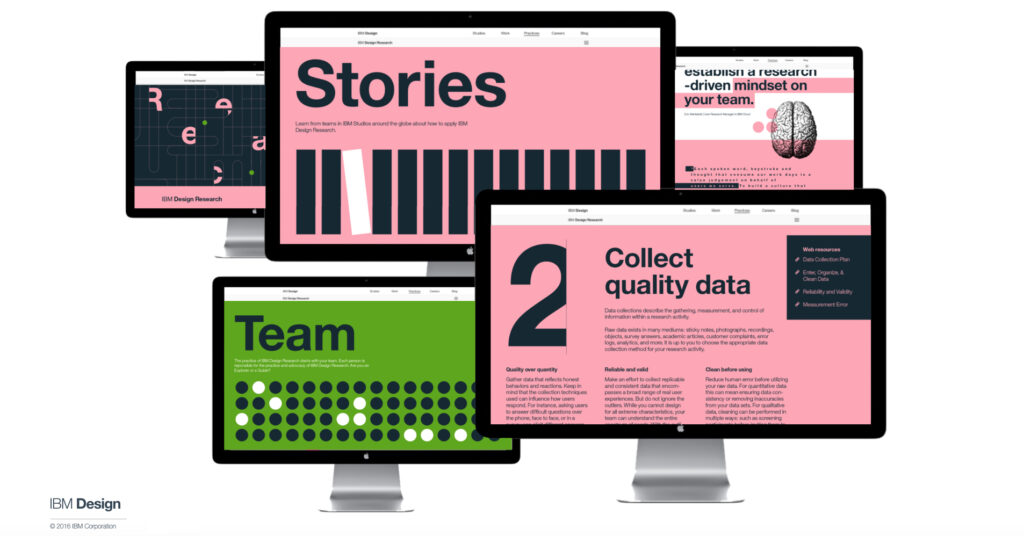
As consultants we practiced the basics of design thinking and user centered design for years with a range of organizations. However, upon joining IBM and learning to apply the IBM Design Thinking mindset, we both realized this way of working differed from our past experiences. This difference is largely expressed by the addition of “the Keys” or IBM’s way to scale design within a large, geographically disparate organization.
As researchers and strategists, the most resonate Key is Sponsor Users. A real challenge for enterprise and healthcare programs is access to users and their environment—rarely can you approach a hospital and ask if you can walk into an operating room with cameras and notepads in hand. In the healthcare space, we overcame the challenge by creating partnerships with clinicians and hospitals. These relationships brought clinicians onto our teams and closed the expertise gap. Clinicians shared with us a day in their lives and showed us their struggles and challenges as we shadowed them.
IBM overcomes challenges with Sponsor Users, or the actual people who use IBM offerings and whom we invite to become part of our enterprise team. Sponsor Users bring their domain expertise, unique physical and virtual environments, and they jobs they need to accomplish to the forefront. In turn, we invite Sponsor Users to co-design with IBM teams. Through these exchanges Sponsor Users help IBM teams stay in touch with real user needs and continually increase understanding and deepen our empathy as we refine and redefine the problem and the solution. While this application of interacting with users sounds similar to approaches used by consultants, it differs in that IBM can scale Sponsor Users across hundreds of teams and hundreds of thousands IBMers.
IBM Design Thinking advocates placing users at the center of our work but internal research indicated a distance between theory and everyday practice. We needed to provide direction on how teams can prioritize user needs and establish a regular cadence with their Sponsor Users. We asked ourselves: How do we complement IBM Design Thinking with the mindset, principles and resources needed for teams to achieve actionable insights? If IBM Design Thinking is the “what” then IBM Design Research needs to be the “how” to scale empathy and user research across the company.
IBM Design Research launched internally in April 2016 and, after multiple iterations, publically launched in June 2016. We leveraged both qualitative and quantitative methods to develop the structure and content based on IBM team needs. Our Sponsor Users helped us understand the challenges of teams across different business units and we invited them to co-design IBM Design Research alongside us.
Forty of our smartest research minds contributed content towards the practice of IBM Design Research. As we curated, analyzed, and structured content, our Sponsor Users reviewed, pushed, and prodded us to make IBM Design Research more applicable. Today all the guidance, tools, agreements and other resources needed to establish a healthy Sponsor User Program and conduct quality design research is available in one place for IBM teams to develop actionable insights. While specifically designed for IBMers, IBM Design Research provides structure for any team looking to engage firsthand with their users and create solutions that will drive positive user outcomes.
Sharing IBM Design Research externally is an opportunity for us to not only help others learn from our work but also initiate dialogue with the greater design research community so that we can all enable engaging user experiences. We look forward to connecting at EPIC2016 to share in your experiences to better inform our own practices.
 Chris Hammond is a Design Research Leader for IBM Design. He leads with courage, integrity and empathy. He is member of the design practices team, which is responsible for enabling all of IBM to think like designers. While leading cross-functional teams at the consultant Kaleidoscope, Chris honed his love for the opportunity space between research and design. One of his most prized experiences as a designer was the creation of an innovation partnership between a pediatric hospital and the consultancy.
Chris Hammond is a Design Research Leader for IBM Design. He leads with courage, integrity and empathy. He is member of the design practices team, which is responsible for enabling all of IBM to think like designers. While leading cross-functional teams at the consultant Kaleidoscope, Chris honed his love for the opportunity space between research and design. One of his most prized experiences as a designer was the creation of an innovation partnership between a pediatric hospital and the consultancy.
 Jesyka Palmer is a Design Research Leader for IBM Design. She believes in delivering offerings in a collaborative, user-centric mindset. While at IBM, Jesyka has worked on various projects including research for the Office of the Chairman, IBM Design Thinking, and the IBM Design Language. She also spoke at IBM Design @ SXSW 2015 on the topic of practicing successful remote collaboration. Jesyka’s previous startup experience includes leading cross-functional teams, raising capital, and conducting speedy research to drive smarter strategies.
Jesyka Palmer is a Design Research Leader for IBM Design. She believes in delivering offerings in a collaborative, user-centric mindset. While at IBM, Jesyka has worked on various projects including research for the Office of the Chairman, IBM Design Thinking, and the IBM Design Language. She also spoke at IBM Design @ SXSW 2015 on the topic of practicing successful remote collaboration. Jesyka’s previous startup experience includes leading cross-functional teams, raising capital, and conducting speedy research to drive smarter strategies.
Related
“Understanding the World through Engagement”: Jeanette Blomberg, A Profile, Christine T. Wolf
Engineers “On The Ground”: Mass Observation at Moto, Stokes Jones & Pree Solari
Evolution of User Experience Research, Kathy Baxter et al

0 Comments